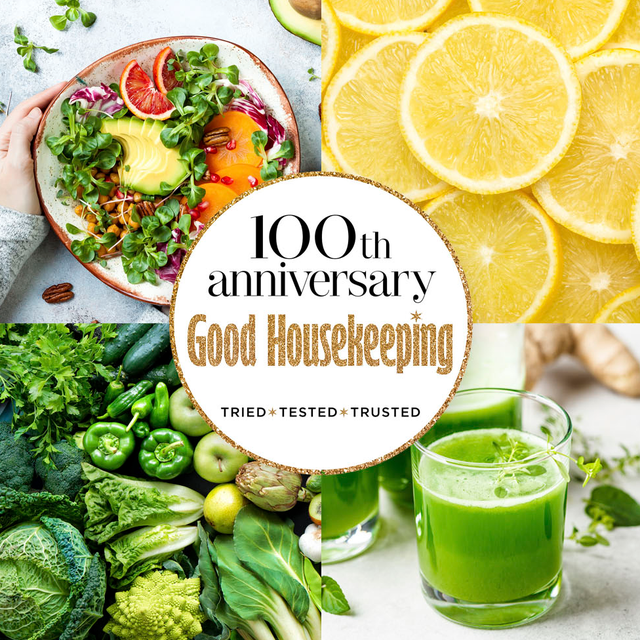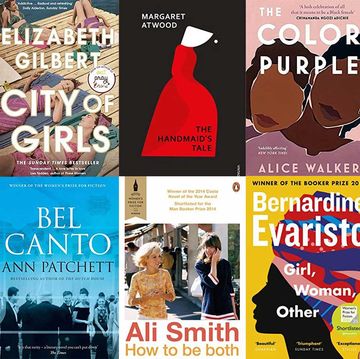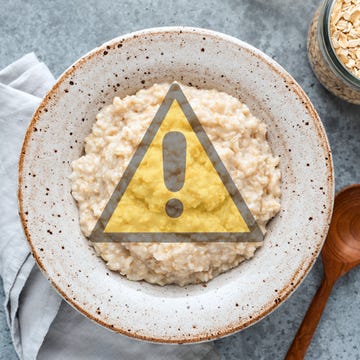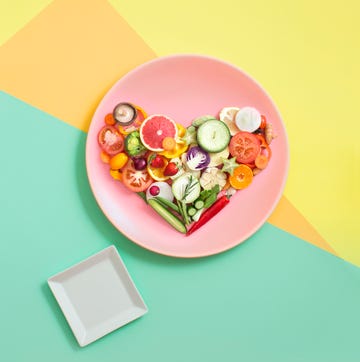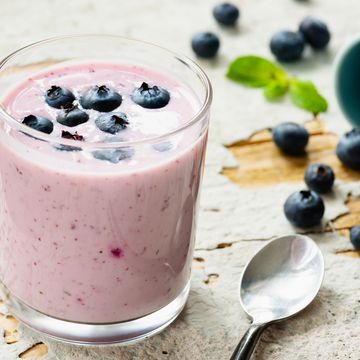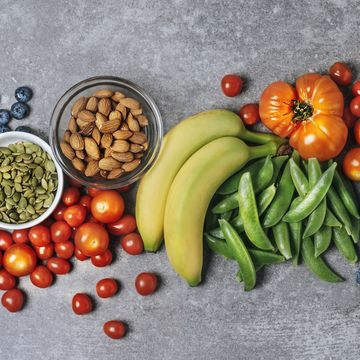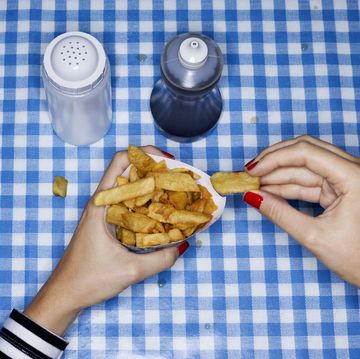Healthy eating doesn’t have to be hard work. Small changes to the food you choose, the way you cook and the way you eat can make a real difference.
To celebrate Good Housekeeping’s centenary, nutritionist Fiona Hunter has compiled 100 quick and simple tips – from smart swaps and new ways to prepare and cook food to clever kitchen gadgets – that will make healthier eating a piece of cake.
Healthy eating advice
1. Look at labels
Traffic light labelling on the front of packs provides an at-a-glance guide to just how healthy (or not) a food is – but don’t forget to check the nutrition panel on the back too, which will help you compare brands, as well as the ingredients list to check what a food really contains.
2. Add a squeeze of lemon
Acidic foods such as lemon will lower the glycaemic index (GI) of pasta and rice, which will slow the conversion of starch to sugar.
3. Garlic: crush it, don't cut it
The more you damage garlic (and onion) cell walls, the more anticlotting sulphur phytochemicals – which help reduce the risk of heart disease and stroke – you release, which is why crushing is better than cutting. Resting crushed garlic for 15 minutes before use will boost levels even further.
4. Out of sight, out of mind
Hide sweets and biscuits away (or better still don’t buy them). Studies show that if you keep the biscuit tin or 'naughty' treats where you can see them, you’re more likely to succumb.
5. Plan ahead
Healthy eating is much easier if you plan your days. Set aside time at the weekend to write a healthy recipe menu plan for the next seven days. This will help you become more organised, and the investment in managing your meals will pay dividends when your energy levels and good intentions may be flagging later in the week.
6. Ring the changes
Variety may be the spice of life but it’s also the key to a healthy balanced diet. No single food or food group can provide all the nutrients your body needs to stay healthy. Eating a wide range of foods is the best way to make sure your diet contains all the nutrients it needs.
7. Homemade for health
Cooking from scratch puts you in control. It means you can improve family favourites by reducing salt, choosing healthy fats and adding ingredients such as beans and wholegrains to boost the fibre.
Healthy eating: ways to improve porridge
8. Chia seeds
A good source of fibre and magnesium.
9. Walnuts
A good source of omega-3 oils.
10. Cinnamon
Helps lower blood sugar and cholesterol levels.
11. Pumpkin seeds
A great source of zinc, important for a healthy immune system.
12. Berries
In fact, add any fruit – fresh, dried, canned or frozen.
13. Time for tea?
Save it for teatime – the tannin in tea reduces the absorption of iron from food, so try not to drink it with meals.
14. Feel the pulse
Canned beans and pulses such as lentils and chickpeas are high in fibre, and just three heaped tablespoons count as one of your 5-a-day (although no matter how much you eat, they will only count as one portion per day). Try adding them to soups, casseroles or salads.
15. Don’t overcook your pasta
Pasta cooked al dente has a lower GI, which means it is digested more slowly, helping you to feel full for longer while keeping blood sugar levels stable.
16. Give peas a chance
Frozen peas are a great standby and, like other frozen vegetables, are a great source of vitamin C. In fact, quickly freezing freshly harvested produce can lock in the vitamins, so frozen fruit and veg often contain higher levels of vitamin C than fresh.
17. Drink more water
Not drinking enough water is one of the most common causes of headaches, poor concentration and tiredness. Long-term dehydration can lead to constipation and urinary tract infections. Download an app such as Waterlogged to remind you to drink regularly.
18. Supercharge your sarnie
Instead of butter, spread bread with mayo, which contains unsaturated fat and is easier to spread, and choose wholemeal bread too. Then add lots of vegetables to the filling.
19. Go to work on an egg
Eggs have a lot to offer – they’re one of the few dietary sources of vitamin D as well as providing good amounts of vitamins A, E, B2 and B12. They are also rich in lecithin and choline, which play an important role in brain function and memory. And don’t just keep them for breakfast – they make a cracking lunch or dinner!
20. Shop online
If you haven’t tried internet food shopping, why not give it a go? It’s quick and easy and you’re less likely to be tempted to buy unhealthy treats and snacks.
21. Get your oats
Oats are rich in beta glucan, a type of soluble fibre that helps the body get rid of unhealthy cholesterol. Studies show that eating just two tablespoons of oats as part of a low-fat diet can help to reduce cholesterol levels. Choose jumbo oats or stone-ground oats rather than the fine-ground types, because they will be absorbed more slowly.
22. Mix up the mayo
Reduce the calorie and fat content of mayo by mixing it 50:50 with plain yogurt. Pep up the flavour by adding chopped fresh herbs, garlic or a dash of mustard.
23. Get into the brekkie habit
Don’t rely on a strong black coffee to give you a kick-start in the morning. Take the time to eat a proper breakfast and you’ll reap the rewards throughout the rest of the day. Studies show that people who eat breakfast are less likely to be overweight and are also less likely to suffer from colds and flu.
24. A little of what you fancy
Allow yourself a treat now and again. If you include the foods you like to eat in your diet – but ‘naughty’ ones in moderation rather than as a daily treat – you’re much more likely to stick with your healthy resolutions in the long term.
25. Eat an apple before your lunch
Research from Penn State University found that people who ate an apple 15 minutes before lunch consumed 190 fewer calories than those who snacked on something else or ate lunch on an empty stomach.
26. Cook your carrots and serve them with a little oil
Cooking carrots helps to break down their tough cell walls, releasing the carotene contained within the cells. The body can absorb around 50 per cent more carotene from cooked carrots than raw – and adding a little butter or olive oil helps to boost the absorption even more.
27. Go nuts
Nuts and seeds are a good source of vitamin E and heart-friendly unsaturated fats. People who eat nuts regularly are less likely to suffer from heart disease. All nuts are healthy but different varieties contain different nutrients, so ring the changes.
28. Be mature
Choose extra-mature rather than mild cheese when you’re cooking. You won’t need to use as much to get the same level of flavour and so will reduce the calorie, fat and salt content of your dish, without losing out on taste.
Kitchen appliances that help make healthy eating a doddle
29. Hand blender
Great for making homemade soup, a healthy lunch that can count as two or even three of your 5-a-day.
30. Juicer
Although most of us are well aware of the recommendation to eat at least five portions of fruit and veg a day, only one in three of us manages to reach the target. Starting the day with a freshly made juice is an easy way to get your first of the day.
31. Slow cooker
At the end of a busy day, cooking a meal is probably the last thing you want to do – which is why these gadgets can be such a good friend. What’s better than arriving home to a delicious stew or casserole? Slow cookers aren’t expensive and are perfect for cooking cheaper cuts of meat. You can even make porridge, cakes and jam in them.
32. Food processor
Cooking from scratch can mean a lot of chopping, grating, slicing and mixing, which is so much quicker (and easier) if you have a food processor.
33. Spiraliser
If you’re watching your weight, following a low-carb diet or simply trying to eat healthily, a spiraliser is well worth the investment as it allows you to create ‘spaghetti’ and ‘noodles’ from a whole range of vegetables including carrots, courgettes, beetroot and sweet potatoes.
34. A cool way to remove fat
Easily remove fat from gravy by adding a couple of ice cubes to it while hot – the fat will congeal around the ice cubes, which you can then remove and discard.
35. Spray oil, don’t pour
To save calories, put your oil in a spray bottle. If you spritz rather than pour, you’ll use a little less when cooking.
36. Don’t brush your teeth immediately after drinking fruit juice
Acidic foods, such as fruit and its juice, weaken the enamel that protects teeth, making it more susceptible to damage. So instead of reaching for the toothbrush immediately after eating these, rinse your mouth with a little water if you like, and wait at least 30 minutes before brushing your teeth.
37. Pick popcorn over crisps
Plain or lightly seasoned popcorn contains twice as much fibre and less fat than crisps, plus popcorn is a wholegrain cereal. Choose air-popped if possible.
38. Don’t forget to grind your flax seeds
Flax seeds are a useful source of omega-3 oils, particularly if you don’t eat oily fish. They also contain phytochemicals called lignans that may help to ease some of the symptoms of menopause. The problem is that they have a tough outer coating, so if you don’t crush them before you use them your body can’t access these nutrients, and you’ll be missing out on the benefits.
39. Grow your own herbs
Herbs don’t require a lot of space or skill to grow and are a good way to flavour your food without adding salt.
40. Pick sweet potatoes over regular
Sweet potatoes are loaded with betacarotene, which the body can convert to vitamin A – and unlike normal white potatoes, they also count towards your 5-a-day.
41. Choose Tenderstem broccoli
This vibrant veg might taste like regular broccoli but actually contains three times more glucosinolates, phytochemicals that are believed to help reduce the of risk heart disease and certain types of cancer.
42. Swap blanched almonds for the skin-on variety
The skin of almonds contains fibre and antioxidants called polyphenols that can help reduce the level of LDL ‘bad’ cholesterol in the blood and reduce the risk of heart disease.
43. Get organised
Spring clean your kitchen cupboards and freezer, and restock with healthy things that will help you make a quick and nutritious meal or snack at the end of a busy day.
44. Replace regular white rice with basmati rice
Basmati rice has a lower glycaemic index (GI) than other varieties, which means that it’s digested more slowly, helping you to feel full for longer and stopping blood sugar levels spiking.
45. Build a better salad
Adding nuts, avocado or an oil-based dressing to your salad will make it easier for your body to absorb any fat-soluble phytochemicals from the salad leaves.
46. Veg boost
Add more vitamins and fibre to dishes such as spaghetti Bolognese, shepherd’s pie and curries by incorporating plenty of veg. This is also a good way to get reluctant veg eaters to eat more.
47. Dish the fish
Dietitians recommend eating two portions of fish each week, one of which should be oil-rich such as salmon, mackerel, sardines, trout and fresh tuna. Omega-3 oils in these fish help to make the blood less sticky, and so may help to prevent blood clots that have the potential to cause a stroke or heart attack.
48. Batch cook
This gives you a stash of healthy home-cooked meals in your freezer for when you don’t have the time or energy to start from scratch.
49. Go for meat-free Mondays
Lean meat can form part of a healthy balanced diet, but you don’t have to eat it every day. Experts agree that a meat-free Monday – or any other day of the week – is good for both you and the environment.
50. Hype your hummus
Add cooked beetroot – beetroot is rich in nitrates that can help to dilate the blood vessels and lower high blood pressure.
51. Pesky pesticides
The Pesticide Action Network UK publishes a ‘Dirty Dozen’ list of the 12 fruit and veg most heavily contaminated with pesticides. Organic produce is farmed without pesticides, so if you can afford to, go organic for these fruit and vegetables:
- Grapefruit
- Soft citrus fruits (mandarins, satsuma)
- Strawberries
- Oranges
- Grapes
- Herbs
- Sultanas and raisins
- Pre-packed salad leaves
- Lemons
- Pears
- Peaches and nectarines
- Spinach
52. Don’t get stuck in a food rut
When was the last time you tried a new recipe or picked up something new in the supermarket? There’s a Japanese proverb that says every new food you introduce into your diet adds seven days to your life.
53 Snack smart
It’s OK to eat between meals providing the snacks you choose are healthy. A good snack should provide between 100-150 calories and make a positive contribution to your diet – so try to choose something rich in vitamins, minerals or fibre, such as a handful of nuts, a couple of oatcakes, yogurt or fresh fruit.
54. Better health by stealth
To reduce fat and boost the fibre in dishes such as spaghetti Bolognese or chilli con carne, choose lean mince and reduce the amount by a third, bulking it up with a can of brown lentils instead. By the time you’ve added other ingredients, such as tomatoes and onions, you won’t notice the difference.
55. Spice things up
New research has found that adding herbs and spices to your diet can help lower your blood pressure and the risk of heart disease and stroke.
56. Ditch crackers for oatcakes
Oatcakes contain twice as much fibre as cream crackers and have a lower glycaemic index (GI), which means they’re digested more slowly, helping to maintain stable blood sugar levels.
57. Keep chips chunky
Thin chips absorb more oil than fat chips: 150g of thick chips would provide around 351cals and 15g fat, while the same weight of thin chips would contain twice as much fat and an additional 195cals.
58. Wholegrains: make the healthier choice
Eating three or more servings of wholegrains a day – such as wholemeal bread, brown rice or wholegrain breakfast cereals – can cut your risk of stroke in half.
59. Choose cherries for a better night’s sleep
Cherries are naturally rich in the sleep-inducing hormone melatonin. A glass of cherry juice (especially tart cherry juice) an hour before bed can help improve sleep duration and quality.
60. Focus on your food
Don’t listen to the radio or watch TV while you’re eating. A study published in the American Journal of Clinical Nutrition found that when people listened to a detective story while eating they consumed 13 per cent more calories than when they had no distractions.
61. Colour yourself healthy
Picture a rainbow and aim to eat at least one serving of fruit or vegetables from each of the colour bands every day. Naturally occurring phytochemicals give fruit and veg their colour, so by opting to "eat the rainbow", you’ll get a variety of different phytochemicals that help to protect against health problems such as cancer, heart disease, poor eyesight, urinary tract infections and even wrinkles.
62. Tan your mushrooms not your skin
Leaving mushrooms in sunlight for 30 minutes before you cook them will boost their levels of vitamin D.
63. Shake the salt habit
Adding flavour with chilli, garlic and lemon instead of salt will help you to cut back on the amount of salt in your diet (no more than 6g per day).
64. Think before you drink
Calories in drinks can add up fast, and the body doesn’t register them in the same way as it does those in food. In a study carried out at Purdue University in Indiana, when people were given an extra 450cals a day in the form of jelly beans, they compensated by eating less at meal times. But when the same people were given an extra 450cals in the form of drinks, there was no such reduction.
65. Swap canned tuna for canned salmon
While fresh tuna is rich in omega-3 oils, most of these healthy fats are removed when the fish is canned. When salmon is canned, however, the omega-3s are retained, which means you get the benefit.
66. Shop little and often
Fresh fruit and veg start to lose their freshness and vitamins from the moment they are picked, and the longer they are stored the greater the loss, so buy little and often.
67. Blocked nose?
Try spicing up your cooking – chillies, ginger and wasabi can help relieve nasal congestion.
68. Harness the power of purple
Purple fruit and vegetables – think blackberries and blueberries – get that distinctive colour from a group of phytochemicals called anthocyanins that offer many health benefits, including better brain function. When fresh berries aren’t in season, look for packs of frozen berries that are cheaper and just as good for you. Use them to make smoothies or fruit purée to stir into yogurt.
69. Choose canned fish for calcium
Canned fish, such as pilchards and sardines, are a great storecupboard ingredient and, if you eat their bones, they're an excellent source of calcium – just one average-sized serving will provide over 50 per cent of the recommended daily amount.
70. Plate up
For a healthy, balanced diet, fill half your plate with vegetables, then 25 per cent protein and 25 per cent carbs.
71. Go nuts
Like all nuts, Brazils are a good source of protein and heart-friendly fats, but what really gives them their superfood status is the impressive amount of selenium they contain. Selenium is a mineral linked to the immune system, fertility and brain function. Many of us don’t get enough, but just five Brazil nuts will provide over 100 per cent of the recommended daily amount.
72. Enjoy your food
After all, food should be a pleasure, not a pain, and research has shown that the more you enjoy your food, the more nutrients your body absorbs from it – it’s a win-win situation.
73. Not a fan of fish?
No problem, but make sure to choose omega-3 enriched eggs to add important heart-healthy oils into your diet. You can boost your intake even further by eating walnuts and flax seeds (see tip 38).
74. Eat by the clock
Eating little and often – three small meals with a couple of healthy snacks – is the best way to keep blood sugar levels stable. When they start to dip, you are more likely to make poor food choices and overeat at mealtimes.
75. Invest in a good heavy-based non-stick pan
Using non-stick pans mean you’ll be able to reduce the amount of oil you need to use. And remember that oil expands once it gets hot, so when you’re softening onions or vegetables you don’t need to add as much as you might think.
76. Keep your good bacteria happy with prebiotics
Onions, bananas, leeks, Jerusalem artichokes and asparagus all contain a special type of fibre that has been shown to encourage the growth of friendly bacteria in your gut.
77. Don’t store tomatoes in the fridge
Tomatoes kept at room temperature contain double the lycopene, a phytochemical that helps protect against heart disease and certain cancers, compared with those stored in the fridge.
78. Souper douper
Studies show that when soup is eaten as the first course of a meal, the total number of calories consumed at that meal is reduced by 20 per cent.
79. Be the first to order
Eating out with a group of friends? When you are the first to order, you are less likely to be swayed if others make not-so-healthy choices.
Healthy eating: Colour-coded food
Some foods let you know their nutritional benefits by standing out from similar varieties.
80. Red peppers
These contain more vitamin C and five times more carotene than green peppers.
81. Gold kiwi
Kiwi contain impressive amounts of vitamin C, but the golden variety contains higher levels of antioxidant polyphenol phytochemicals and around 50 per cent more vitamin C.
82. Pink and red grapefruit
Sweeter than regular grapefruit, these contain 34 per cent more betacarotene, which the body converts into vitamin A.
83. Red onions
These have higher levels of the heart-healthy phytochemicals quercetin and anthocyanin than white varieties – and shallots are even higher.
84. Black grapes
Swap green grapes for black – both are a good source of vitamin C, but black grapes contain higher levels of the antioxidants that help protect against heart disease.
Healthy eating: Perfect partners
There are certain foods and drinks that, when eaten together, not only taste great but give you added health and nutrition benefits.
85. Eggs with salad
In one study, men who ate salad made from tomatoes and carrots absorbed between three and nine times more carotenoids from the salad when it was eaten with an egg.
86. Pork and papaya
Because pork is so lean it can be tough, so try tenderising it – and boosting the flavour – with papaya or pineapple. These fruits contain enzymes – bromelain in pineapple and papain in papaya – which split the proteins in meat, helping to make it tender.
87. Avocado and tomato
The fat in the avocado boosts the absorption of the phytochemical lycopene from tomatoes – one study found absorption was five times higher when the two were eaten together.
88. Broccoli and tomatoes
The cancer-fighting potential of tomatoes and broccoli is enhanced when the two foods are eaten together.
89. Orange juice with beans on toast
The vitamin C in orange juice will make it easier for your body to absorb iron from foods such as beans, lentils and breakfast cereals. Absorption of iron can be increased by over 50 per cent when the two foods are eaten together.
90. Get fruity
Swap some of the butter or margarine in cake and muffin recipes for fruit such as apple sauce or prune purée. Not only does it add moisture and a delicious fruity taste, it boosts the fibre content of the baked goods too. Simply replace half the amount of fat in the original recipe with the fruit purée.
91. Bigger is not always better
Cherry tomatoes contain higher levels of flavonols, antioxidants believed to help protect against heart disease, stroke and cancer, than beefsteak or normal-sized varieties.
92. Take a supplement of the sunshine vitamin during the winter
In summer the body can make vitamin D by the action of sunlight on skin, but in autumn and winter, even on a sunny day, the sun is at the wrong angle to allow the body to make this vitamin. So from September to March, take a supplement of 10mcg vitamin D per day.
93. The future is orange
One of the best things you can do to keep skin looking great is to eat lots of fruit and vegetables, particularly citrus fruits. These are a great source of vitamin C, an antioxidant that helps to neutralise free radicals, which cause ageing and wrinkling.
94. The big chill
Make soups and casseroles the day before you need them and store them overnight in the fridge. Fat will rise to the surface, making it easier for you to remove it before reheating. Plus, many dishes often taste even better the day after, as the flavours have more time to develop.
95. Soak up the fat
Blot deep-fried food with kitchen roll before serving it to remove any excess oil. Soaking up just one teaspoon of oil will save you 30cals and 3g fat!
96. Take your supplements with food
Most supplements are better absorbed if you take them with a meal, especially something containing a little fat.
97. Slow down
It takes 15 minutes for your brain to receive messages from your stomach saying it’s full. If you eat quickly, you can overeat before your brain realises you’ve had enough.
98. Swap honeydew melon for watermelon
Watermelon gets its colour from lycopene, a phytochemical that helps protect against heart disease and some types of cancer.
99. Boost your good gut bacteria with fermented foods
The friendly bacteria living in our gut are vital for a healthy immune system, but the balance of good and bad bacteria is easily upset if we don’t eat the right food. Supplement yours by regularly eating fermented foods including yogurt, kefir, kombucha, kimchi and sauerkraut.
100. Don’t be afraid of the dark
Darker, more strongly flavoured salad leaves such as rocket, spinach and watercress, have higher levels of vitamins and phytochemicals than paler leaves. Watercress contains 12 times more vitamin C and three times more iron than ordinary white lettuce.
